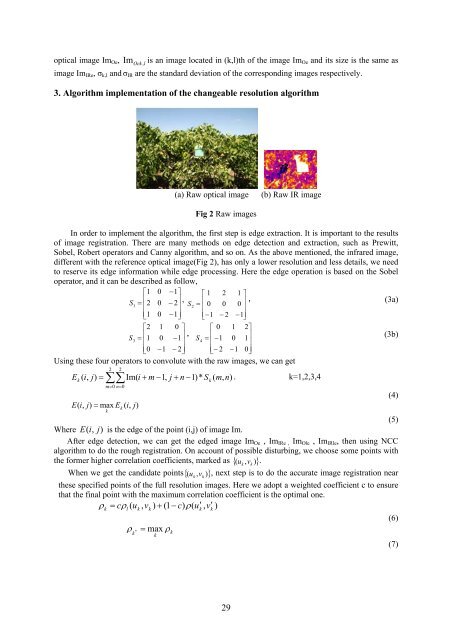Workshop proceeding - final.pdf - Faculty of Information and ...
Workshop proceeding - final.pdf - Faculty of Information and ...
Workshop proceeding - final.pdf - Faculty of Information and ...
You also want an ePaper? Increase the reach of your titles
YUMPU automatically turns print PDFs into web optimized ePapers that Google loves.
optical image Im Oe ,<br />
Im Oek,l<br />
is an image located in (k,l)th <strong>of</strong> the image Im Oe <strong>and</strong> its size is the same as<br />
image Im IRe , σ k,l <strong>and</strong> σ IR are the st<strong>and</strong>ard deviation <strong>of</strong> the corresponding images respectively.<br />
3. Algorithm implementation <strong>of</strong> the changeable resolution algorithm<br />
(a) Raw optical image<br />
(b) Raw IR image<br />
Fig 2 Raw images<br />
In order to implement the algorithm, the first step is edge extraction. It is important to the results<br />
<strong>of</strong> image registration. There are many methods on edge detection <strong>and</strong> extraction, such as Prewitt,<br />
Sobel, Robert operators <strong>and</strong> Canny algorithm, <strong>and</strong> so on. As the above mentioned, the infrared image,<br />
different with the reference optical image(Fig 2), has only a lower resolution <strong>and</strong> less details, we need<br />
to reserve its edge information while edge processing. Here the edge operation is based on the Sobel<br />
operator, <strong>and</strong> it can be described as follow,<br />
⎡1<br />
0 −1⎤<br />
⎡ 1 2 1 ⎤<br />
S =<br />
⎢ ⎥<br />
⎢<br />
2 0 − 2 , , (3a)<br />
1<br />
⎥ S<br />
⎢<br />
⎥<br />
2<br />
=<br />
⎢<br />
0 0 0<br />
⎥<br />
⎢⎣<br />
1 0 −1⎥⎦<br />
⎢⎣<br />
−1<br />
− 2 −1⎥⎦<br />
⎡2<br />
1 0 ⎤ ⎡ 0 1 2⎤<br />
S =<br />
⎢ ⎥<br />
⎢<br />
1 0 −1<br />
,<br />
3<br />
⎥<br />
S<br />
⎢ ⎥<br />
(3b)<br />
4<br />
=<br />
⎢<br />
−1<br />
0 1<br />
⎥<br />
⎢⎣<br />
0 −1<br />
− 2⎥⎦<br />
⎢⎣<br />
− 2 −1<br />
0⎥⎦<br />
Using these four operators to convolute with the raw images, we can get<br />
2<br />
2<br />
∑∑<br />
E ( i,<br />
j)<br />
= Im( i + m −1,<br />
j + n −1)*<br />
S ( m,<br />
n)<br />
. k=1,2,3,4<br />
k<br />
m= 0 n=<br />
0<br />
E( i,<br />
j)<br />
= max E ( i,<br />
j)<br />
k<br />
k<br />
k<br />
(5)<br />
Where E( i,<br />
j)<br />
is the edge <strong>of</strong> the point (i,j) <strong>of</strong> image Im.<br />
After edge detection, we can get the edged image Im Oe , Im IRe , Im Ole , Im IRle , then using NCC<br />
algorithm to do the rough registration. On account <strong>of</strong> possible disturbing, we choose some points with<br />
the former higher correlation coefficients, marked as {( u<br />
k<br />
, vk<br />
)}.<br />
When we get the c<strong>and</strong>idate points{ ( u k<br />
, v , next step is to do the accurate image registration near<br />
k<br />
)}<br />
these specified points <strong>of</strong> the full resolution images. Here we adopt a weighted coefficient c to ensure<br />
that the <strong>final</strong> point with the maximum correlation coefficient is the optimal one.<br />
ρ<br />
k<br />
= c ρl<br />
( uk<br />
, vk<br />
) + (1 − c)<br />
ρ(<br />
u′<br />
k<br />
, v′<br />
k<br />
)<br />
(6)<br />
ρ max ρ<br />
* =<br />
k<br />
k<br />
k<br />
(4)<br />
(7)<br />
29
















